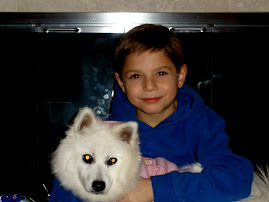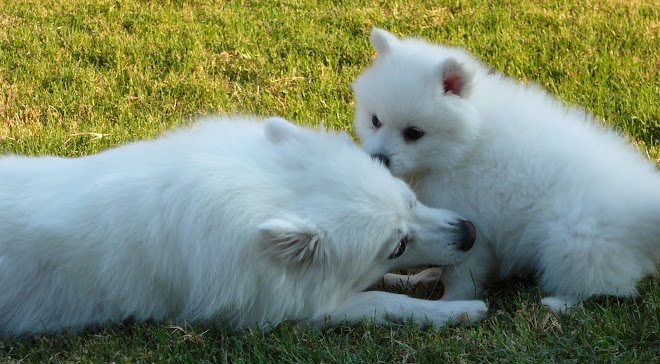 December 24, 2009
December 24, 2009If you're at all like me, you love baking Christmas cookies. And, if your dogs are like mine, they sit patiently in kitchen, puppy-dog eyes HUGE with excitement, drooling in hopes and anticipation of their mommy (me) accidentally dropping a tasty scrap of some food on the floor.
Well, imagine your dog's excite when she discovers that the cookies you've been making in the kitchen this whole time are actually treats for her! That's right! Why should people get to eat all the wonderful, edible treats this time of year? Here are two special recipes for doggie Christmas treats that your pooch is sure to love:
Doggie Christmas Cake Ingredients:
2 cups of whole wheat flour
¼ cup of wheat germ
2 teaspoons of baking powder
1 teaspoons of ground cinnamon
1 cup of molasses
½ cup of canola oil
2 eggs
1 teaspoon of vanilla extract
1 apple, cored and chopped
Directions: Preheat the oven to 350 degrees F. Oil a 12-cup bundt pan with vegetable oil and flour. In a bowl mix the flour, wheat germ, baking powder, and cinnamon together and set it on the side. Then in another large bowl mix together the molasses, and oil, then add in the eggs one by one, and beat them until they blend in. then add in the vanilla along with ½ cup of water. Add the flour mixture to the wet mixture and mix it well until it becomes smooth. Then fold in the chopped apple pieces.
Put the batter into the pan and place in the oven. Bake for around 30 to 40 minutes or until when inserting a toothpick in the center of a cake it comes out clean. Once done allow the cakes to cool completely before serving.
Peanut Butter Slice and Bake Biscuits
Ingredients:
1 cup whole wheat flour
¾ cup smooth peanut butter
½ cup water
2 tablespoons molasses
2 tsp plain wheat germ
¼ tsp sea salt
¼ cup shredded dried beef, saved for top of cookies
Directions:
Pre-heat oven to 375°.
In a pot on top of the stove, place your peanut butter, molasses, water, wheat germ and salt. Warm at medium heat.
Melt the ingredients together, whisking quickly.
Once melted and smooth, take the peanut butter mixture, which should now be nearly liquid, and put in a small bowl.
Measure your flour into a large mixing bowl, and fold in your liquid mixture slowly until your dough is soft. Be sure to have a well-floured board ready to go!
Once you have your dough mixed to the consistency you desire, turn it onto your floured board, roll it into a log shape. Place it in the refrigerator for two hours, until your dough is hard enough to slice into ¼-inch sections. If you are in a real rush, you can place it in the freezer for ½ hour until firm.
Have a cookie sheet ready to go, and spray it lightly with a non-stick spray.
Place your slice and bake cookies on the cookie sheet.
Put the dried beef in a blender or food processor to chop it.
Sprinkle the top of each cookie with your shredded, dried beef.
Bake for 25 minutes. Turn off the oven and let your cookies dry out as the oven cools down. This will make them hard and help keep them fresh. It will also bring out the flavor and make it more intense.
Once your cookies have completely cooled, it is time to place them in an air-tight container. You can either gift wrap them if you are giving them as a gift, or store them in your freezer up to three months until you are ready to serve them. You can also store them in the refrigerator for up to two weeks.
To save time in a pinch, you can also make the dough and freeze it for up to three months until you are ready to use it. I love these slice and bake treats because they are fun, fast and, most of all, easy!













 Pia Silvani, certified dog trainer and animal behavior consultant, suggests dual toy storage: Allow only chew toys in the house. Keep raucous-time fetch toys outdoors, perhaps in a bin on the back porch. Not only is this orderly, but this way the dogs learn that when it's time for [rambunctious] play, we go outside.
Pia Silvani, certified dog trainer and animal behavior consultant, suggests dual toy storage: Allow only chew toys in the house. Keep raucous-time fetch toys outdoors, perhaps in a bin on the back porch. Not only is this orderly, but this way the dogs learn that when it's time for [rambunctious] play, we go outside.



+-+9+wks+old.jpg)
 s.
s.






















